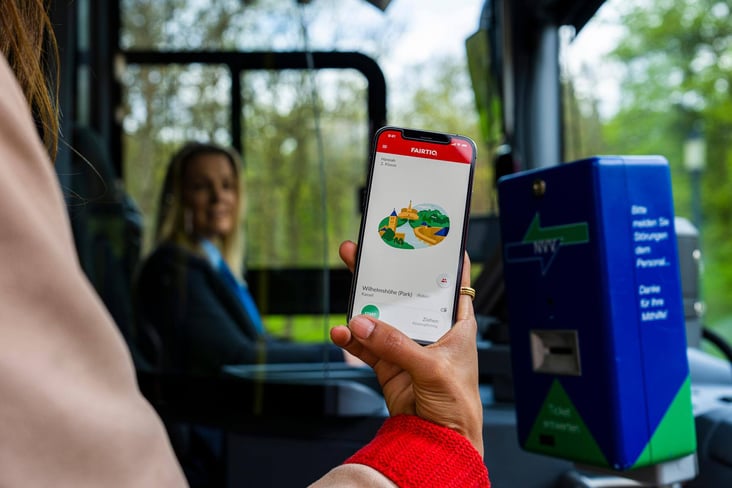
Why Fraud Prevention in Digital Ticketing Matters
No ticketing system is immune to fraud. Whether intentional or accidental, fare evasion leads to lost revenue, operational inefficiencies, and eroded trust in public transport. For digital pay-as-you-go (DPAYG) ticketing solutions like FAIRTIQ, preventing fraud is not just about protecting revenue—it’s about ensuring a fair and seamless experience for all passengers.
As digital ticketing adoption grows, so do the tactics used to exploit it. This is why FAIRTIQ continuously enhances its fraud detection and prevention mechanisms, ensuring compliance with industry standards like the Swiss Automated (DPAYG) Ticketing Standard while staying ahead of emerging threats.
The Challenge: Incorrect Tickets, Lost Revenue, and Unfair DistributionNot every case of incorrect ticketing is deliberate fraud. Some passengers misunderstand fare rules, while others may knowingly exploit loopholes. Either way, the result is the same:
Without proper detection, an uninspected passenger with the wrong ticket will never be flagged—causing financial and operational inefficiencies across the system. The Solution: FAIRTIQ Ensures the Right Ticket for Every JourneyFAIRTIQ eliminates ticketing guesswork. By reducing the complexity in ticket purchasing, the potential for conflicts with inspection staff also decreases. Whether a journey is inspected or not, FAIRTIQ ensures: |
How FAIRTIQ Fights Fraud: A Multi-Level Approach
In addition to automatically selling the right ticket, FAIRTIQ employs a proactive, multi-level strategy to tackle fraud, combining prevention, AI-powered detection, and fair enforcement.

1. Prevention: Stopping Fare Evasion Before It Happens
Prevention is the first line of defence. By integrating smart safeguards, FAIRTIQ ensures that users meet key conditions before they can travel, without adding unnecessary complexity. Key measures include:
- Valid payment method required: Users must register a legitimate payment method before using FAIRTIQ.
- Check-in restrictions: Users can only check in when near a station, reducing the risk of late check-ins.
- Check-out validation: Journeys are finalised only when users are no longer on public transport and their location is verified, preventing early check-outs.
These and more measures create a frictionless yet secure process that reduces the risk of fraud or the wrong ticket being purchased.
2. AI-Powered Fraud Detection: Ensuring Fair and Accurate Ticketing
Unlike traditional ticket inspections that capture only a snapshot of passenger activity, FAIRTIQ’s AI-driven system analyses travel patterns at scale, identifying suspicious patterns early and ensuring accurate fare collection.-1.png?width=625&height=254&name=Prevention%20(2)-1.png)
Common Fare Evasion Tactics – and How FAIRTIQ Prevents Them
Fraud comes in many forms, from minor misunderstandings to deliberate deception. Here are some common tactics and how FAIRTIQ mitigates them:
1. Purchasing a Ticket for a Shorter Journey
Some passengers deliberately buy a ticket for a shorter distance than their actual trip, hoping to avoid inspection.
Example: A Half-Fare Affair 💔
London Northwestern Railway uncovered a major fraud case where an individual consistently underpaid by purchasing tickets that covered only part of their actual route. The deception led to an estimated loss of £7,500. (Source)
2. Buying a Ticket for a Cheaper, Alternative Route
Instead of purchasing a ticket for their actual itinerary, some travelers exploit fare differences by choosing a similar but cheaper route.
Example: Direct Route, Direct Removal ❌
An 11-year-old boy travelling from Biberist to Thun, Switzerland, had a valid ticket but was removed from the train because he took a direct service that cost CHF 3.80 more than his original itinerary. (Source)
3. Using a Ticket or Pass with the Wrong Time Validity
Fare evaders may intentionally or unintentionally buy off-peak or weekend tickets but use them during peak hours, avoiding the higher fare.
Example: Peak Mistake 😢
A passenger from Glossop mistakenly used his 16-25 Railcard during peak hours, underpaying by £1.90. Despite offering to pay the difference or a fine, he faced legal action from Northern Railway. (Source)
4. Misusing Travel Passes and Discount Cards
Some passengers misuse travel discount cards by travelling outside their permitted conditions, using expired or borrowed passes, or falsifying details.
Example: Deutschland Trick-et 🤥
Investigations uncovered fraud involving the Deutschland-Ticket, a nationwide public transport pass in Germany, with criminals using false or stolen account details. DVB reported 15,000 cases, though the full extent remains unclear as victims must first detect and report unauthorised charges. (Source)
Example: Fake It... Till You Don't Make It 🤦♂️
Over four years, a UK passenger used counterfeit tickets to travel across the rail network until apprehended by rail staff and British Transport Police. An expert witness estimated the loss in revenue was anywhere between £27,000.00 and £66,000.00. (Source)
Automated (DPAYG) ticketing solutions like FAIRTIQ prevent such fraud cases by ensuring that passengers always have the right ticket, reducing fare evasion and revenue loss while enhancing convenience. FAIRTIQ’s AI fraud detection analyses system-wide travel behaviour to flag suspicious activities, ensuring fair ticketing for all.
3. Smart Enforcement: An Extra Layer of Security
Once potentially fraudulent trips are flagged, FAIRTIQ’s dedicated fraud team reviews suspicious activities after the journey and takes appropriate action based on local laws and regulations. FAIRTIQ’s process is like the “Yellow Card” system that was recently recommended by Transport Focus in the UK (Source).
While inspectors remain essential, DPAYG ticketing ensures that fare compliance continues beyond on-the-spot checks. FAIRTIQ’s back-office system:
✅ Tracks repeat offenders and can block those with unpaid invoices.
✅ Reduces conflict by handling disputes through back-office analysis rather than face-to-face confrontations.
✅ Improves future fraud detection as AI models continuously learn from real cases.
By combining manual inspections with back-office monitoring, FAIRTIQ ensures a more comprehensive and conflict-free approach to fare enforcement.
Why Fraud Prevention Is a Core Investment
For digital ticketing solutions, robust fraud prevention isn’t optional—it’s essential. Without effective safeguards, a ticketing system loses credibility and financial sustainability. FAIRTIQ’s commitment to fair ticketing ensures that:
✅ Passengers always have the right ticket, with the right discounts, concessions and incentives automatically applied, reducing conflicts and uncertainty.
✅ Operators receive accurate revenue, supporting long-term service improvements.
✅ Transport data remains reliable, helping optimise networks and services.
As FAIRTIQ expands, investing in fraud prevention remains a top priority—ensuring secure, easy-to-use digital ticketing for passengers and providers alike.
Eliminating Fare Confusion to Boost RidershipData from the Rail Delivery Group (RDG), which represents UK train operators, shows that 35% of people who could travel by train choose not to because they struggle to find the right fare. (Source) This uncertainty creates anxiety about unintentionally committing fare fraud, facing prosecution, or even receiving a criminal record—leading them to opt for alternative transportation. FAIRTIQ eliminates this confusion by ensuring passengers always have the right ticket. By simplifying the ticketing process and reducing the risk of accidental fraud, FAIRTIQ builds trust in the system and encourages more people to travel by train. |
Want to Learn More?
Curious about how FAIRTIQ’s fraud prevention strategies can support your transport network? Get in touch with our team.





.jpg?width=732&name=220907hallandstrafiken-buss7103%20(2).jpg)


Share